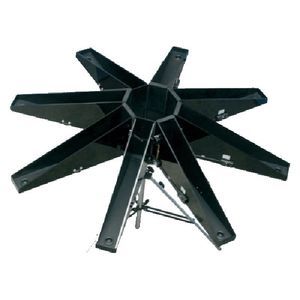
Mice animal research cage LE509modular
Add to favorites
Compare this product
Characteristics
- Animal type
- for mice
- Configuration
- modular
Description
The 9-hole box is commonly used to evaluate attention performance using a visual discrimination task in laboratory animals. Ideally, the nine-hole box setting should be composed by a test chamber, food or drink dispenser, an interface to connect it to the PC and the PackWin software. Our solution is easy-to-wash and offers a solid design as well as great flexibility to accommodate all your research needs.
Presentation
The 5/9 hole box is assembled with black aluminium walls and a transparent front door.
The box is equipped with an arc of 9 contiguous apertures set into the rear wall, a house light, a food pellet dispenser and a ‘pusher’ to detect the nose-pokes into the food holder. The holes not used in the experiment may be blocked up using a metal insert. Each hole is equipped with photocell beams and internal LED providing visual cues specific to each hole. The intensity of the LED can be adjusted in Link Box using the digital selector.
9-Holes box with 9 pellet dispenser
Our solution is easy-to-wash and offers a solid design as well as great flexibility to accommodate all your research needs.
Operating principle
Different experimental paradigms for sustained attention, animal models of impulsive behavior and lateralized-discrimination task can be conducted using the BIOSEB chamber.
As an example, in the 5-choice serial reaction time task, short-lasting stimuli are given in pseudo-randomised order in one of the holes of the cage (commonly, hole 1, 3, 5, 7 or 9). If the animal nose-pokes into the correct hole, a reinforcement (pellet) is given. If the animal nose-pokes into an incorrect hole, a time-out period (no light) is given and next trial begins.
Catalogs
No catalogs are available for this product.
See all of Bioseb‘s catalogsRelated Searches
- Anatomy model
- Demonstration anatomical model
- Demonstration simulator
- Thermometer
- SpO2 monitor
- Digital thermometer
- Surgical anatomical model
- Surgical simulator
- Infrared thermometer
- Whole body anatomical model
- Non-contact thermometer
- Pad simulator
- Emergency care simulation unit
- Vital signs monitoring device
- Probe thermometer
- Compact pulse oximeter
- Wound management simulator
- Articulated anatomical model
- Suture simulator
- Blood pressure vitals monitor
*Prices are pre-tax. They exclude delivery charges and customs duties and do not include additional charges for installation or activation options. Prices are indicative only and may vary by country, with changes to the cost of raw materials and exchange rates.

















